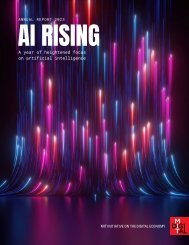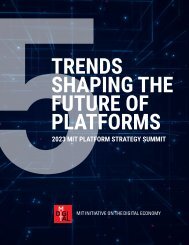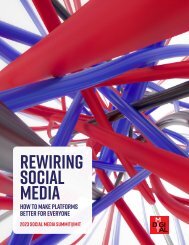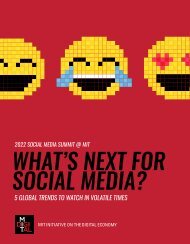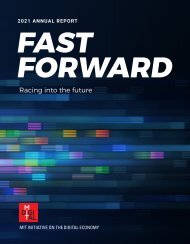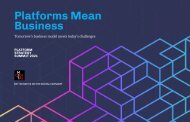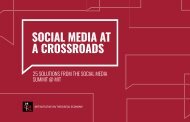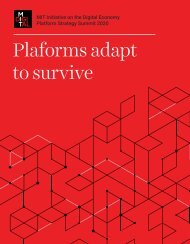platform-2018-v05
Create successful ePaper yourself
Turn your PDF publications into a flip-book with our unique Google optimized e-Paper software.
<strong>2018</strong><br />
PLATFORM<br />
STRATEGY<br />
SUMMIT
Everywhere<br />
there can be<br />
a <strong>platform</strong>,<br />
there will be<br />
a <strong>platform</strong>.<br />
04 <strong>2018</strong> PLATFORM REVIEW AND FORECAST<br />
06 DEMOCRATIZING TRAVEL<br />
08 BLOCKCHAINS AND PLATFORMS<br />
10 LESSONS IN CROWDSOURCING<br />
12 PLATFORMS FOR OPPORTUNITY AND INCLUSION<br />
14 SUMMIT SNAPSHOTS<br />
16 DRIVING GROWTH IN MULTI-SIDED MARKETS<br />
18 A BLUEPRINT FOR DIGITAL PLATFORMS<br />
20 AI AND DATA-DRIVEN BUSINESS INNOVATION<br />
22 ENTERTAINMENT MEETS PLATFORMS<br />
24 HEALTHCARE PLATFORMS AND DIGITAL HEALTH<br />
26 KEY THEMES<br />
02 \
Alice Raia, VP of Digital Presence Technologies for Kaiser Permanente, talks about the keys to succesful healthcare <strong>platform</strong>s.<br />
Platform-centered markets are<br />
booming and business-to-business<br />
and business-to-consumer <strong>platform</strong>s,<br />
such as Amazon and Facebook,<br />
have become household names.<br />
Meanwhile, incumbent companies<br />
are racing to catch the wave.<br />
There is a tremendous need to<br />
understand the economic, policy,<br />
and management sides of<br />
<strong>platform</strong>s—and to learn from<br />
visionaries on the leading edge,<br />
such as Airbnb, Uber, and Topcoder.<br />
On July 13, more than 300 leading thinkers,<br />
executives, entrepreneurs, technologists, and<br />
visionaries descended on MIT’s Media Lab for<br />
the sixth annual MIT Platform Strategy Summit.<br />
Hosted by the MIT Initiative on the Digital<br />
Economy (IDE) and sponsored by KPMG, the<br />
daylong event offered insights, experiences,<br />
and expectations for future direction.<br />
Top-of-mind issues included the implications of<br />
artificial intelligence (AI) and machine learning<br />
(ML), blockchain-enabled technologies, data<br />
privacy, and emerging regulations.<br />
In addition, attendees learned about emerging<br />
<strong>platform</strong> developments in the entertainment and<br />
healthcare markets, and discussed the heated<br />
competition for developer talent and the need<br />
for more inclusive and diverse hiring.<br />
The MIT Platform Summit was launched in 2013 by Geoffrey Parker and Marshall Van Alstyne to explore<br />
the phenomenon of <strong>platform</strong>s in public and private organizations, and to better understand how to manage,<br />
govern, and regulate <strong>platform</strong>s. The Summit brings together thought leaders from industry and academia<br />
to share their experiences, engage in robust discussion, and to help chart a path forward for private and<br />
public-sector leaders who seek better understanding and more efficient regulation.<br />
MIT IDE <strong>2018</strong> PLATFORM STRATEGY SUMMIT / 03
Summit co-chairs (from left) Geoffrey Parker, Peter Evans, and Marshall Van Alstyne served as panel moderators.<br />
WELCOME<br />
Platform Forecast<br />
GEOFFREY PARKER Professor, Dartmouth, and MIT IDE Digital Fellow<br />
MARSHALL VAN ALSTYNE Professor, Boston University<br />
PETER EVANS Principal, KPMG<br />
The Summit co-chairs outlined the rapidly changing<br />
market trends in <strong>platform</strong>s today and highlighted key<br />
milestones that <strong>platform</strong> companies have achieved<br />
during the past year. They also discussed the significant<br />
value of data in a world of <strong>platform</strong> dominance.<br />
KEY THEMES<br />
DATA IS A FUEL—AND SOMETIMES<br />
A FIRE—FOR PLATFORMS.<br />
PLATFORM COMPANIES HAVE BECOME<br />
POWERFUL INNOVATION ENGINES.<br />
REGULATION IS RESHAPING THE<br />
STRATEGIC PLATFORM LANDSCAPE.<br />
EVERYWHERE THERE CAN BE A<br />
PLATFORM, THERE WILL BE A PLATFORM.<br />
PLATFORMS ARE BECOMING AN INTEGRAL<br />
PART OF ECONOMIES WORLDWIDE.<br />
04 \
TRENDS<br />
REGULATIONS<br />
A raft of new local, national, and international<br />
regulations is impacting <strong>platform</strong> companies and<br />
rippling into their planning strategies. Notably, the<br />
General Data Privacy Regulation (GDPR), introduced<br />
in May, expands the data rights of residents of the<br />
European Union. The regulations include broader<br />
rights to be informed, rights to data access, and the<br />
right to correct information and problems. Another<br />
set of EU regulations, the Payment Services Directive<br />
Second Edition (PSD2), requires EU banks to open<br />
their systems to licensed third parties so that<br />
consumers can access banking information from a<br />
variety of <strong>platform</strong>s, such as Facebook or Amazon.<br />
TECH TALENT<br />
As <strong>platform</strong>s proliferate, the battle for tech<br />
talent—particularly software developers and data<br />
scientists—continues to escalate and drive market<br />
consolidation. High-profile acquisitions, such as<br />
Microsoft buying GitHub, and Google scooping<br />
up Kaggle, are making headlines as ways to buy<br />
large pools or talent. Yet, minorities continue to be<br />
underrepresented in the technology industry and<br />
diversity is still an elusive goal.<br />
ECONOMIC IMPACT<br />
Platforms are having a deflationary effect on the<br />
economy. Whether the service is cars (Uber) or<br />
spare bedrooms (Airbnb), <strong>platform</strong>s are improving<br />
operational and market efficiency by tapping spare<br />
capacity, but at the same time, they are lowering<br />
prices, to the delight of consumers.<br />
INNOVATION, NEW OPPORTUNITIES<br />
Digital <strong>platform</strong>s are creating new markets and<br />
new supply-chain models for technology products.<br />
For instance, it’s estimated that nearly half of U. S.<br />
homes will have a smart speaker/voice technology<br />
system by 2022. Industry analysts project that the<br />
market could grow to $18.3 billion in the next five<br />
years, with 870 million devices deployed globally.<br />
In addition to smart speakers, smartwatches and<br />
wearable electronics, as well as augmented and<br />
virtual reality systems, are on the rise.<br />
As a result of this growth, intermediaries will be<br />
needed to become brokers between individuals’<br />
data and the <strong>platform</strong>s that want access to that data.<br />
Focused advertising services will also emerge along<br />
the way. It remains to be seen whether banks,<br />
utilities, big tech <strong>platform</strong>s, or some other entities<br />
will take on the role of the middleman to create<br />
value in these still-immature markets.<br />
YOU<br />
FOR<br />
SALE<br />
TYPES OF DATA FOR SALE<br />
Browsing history<br />
Age<br />
Religion<br />
Income<br />
Mortgage<br />
Charitable donations<br />
Social media<br />
Purchase history<br />
Race<br />
Education<br />
Homeowner status<br />
Investments<br />
Political donations<br />
Email + texts<br />
POTENTIAL INTERMEDIARIES<br />
Banks<br />
Utilities<br />
Big tech <strong>platform</strong>s<br />
ISSUES<br />
Information assymetry<br />
Financial firms<br />
Posts<br />
Trust<br />
MIT IDE <strong>2018</strong> PLATFORM STRATEGY SUMMIT / 05
CASE STUDY<br />
Democratizing Travel<br />
PETER COLES Chief Economist, Airbnb<br />
After eight years teaching at Harvard Business School,<br />
Peter Coles left academia for industry. He first served at<br />
eBay before joining Airbnb in 2015. Now the company’s<br />
chief economist, Coles leads a team of data scientists<br />
and Ph.D. economists, that, as he describes it, “think<br />
about marketplace challenges.”<br />
3 TAKEAWAYS<br />
MAKE INFORMED DECISIONS ACROSS<br />
THE ORGANIZATION VIA DATA ACCESS,<br />
DATA TOOLS, AND DATA EDUCATION.<br />
AN INTERNAL DATA UNIVERSITY FOR<br />
MORE THAN 3,000 EMPLOYEES WILL<br />
TEACH AND SHARE DATA ANALYTICS<br />
AND OTHER SKILLS.<br />
INVEST IN SKILLS DEVELOPMENT AND<br />
INFRASTRUCTURE SUPPORT TO GROW<br />
THE PLATFORM.<br />
Airbnb lists more than 5 million homes<br />
in 81,000 cities and 191 countries.
It’s important that data is available to everybody<br />
and that we have a single source of truth.<br />
PETER COLES Chief Economist, Airbnb<br />
As a <strong>platform</strong>, Airbnb has unlocked a new world of travel<br />
and economic opportunities for guests and hosts alike.<br />
The company is a perfect example of leveraging <strong>platform</strong><br />
data as a corporate priority. Coles said that data analysis<br />
has revealed some surprising insights into how Airbnb<br />
is affecting the members of its community–from who is<br />
using the <strong>platform</strong>, to the opportunities that participation<br />
in Airbnb offers both hosts and guests.<br />
THE POWER OF PLATFORMS + DATA<br />
Coles noted that Airbnb is making it possible for more<br />
people to travel than ever before, at better prices, and<br />
to more destinations. These experiences all demonstrate<br />
the power of <strong>platform</strong>s.<br />
“We not only provide the <strong>platform</strong>, we also manage<br />
payment, risk, customer service, and rating systems.”<br />
Hosts define pricing, house rules, and availability—<br />
and keep 97 percent of the list price. The company<br />
has worked hard to match people on the <strong>platform</strong> to<br />
create value. “We have more than 5 million listings<br />
on the <strong>platform</strong>. We’re in 81,000 cities around the<br />
world and 191 countries.”<br />
Airbnb takes data extremely seriously and operates<br />
on the principle that every employee should be datainformed.<br />
There are three pillars to this principle: Data<br />
access, data tools, and data education. “It’s important<br />
that data is available to everybody and that we have a<br />
single source of truth.”<br />
Airbnb stands behind this commitment with Data<br />
University, where employees, mostly data scientists,<br />
teach classes at all levels about data-informed decision<br />
making. At the higher end, there are even classes in<br />
causal inference, econometrics, and machine learning.<br />
Data analysis forms the backbone of many policies at<br />
Airbnb today.<br />
Coles also noted that data analysis can upend long-held<br />
assumptions about <strong>platform</strong> users. For example, while<br />
men between the ages of 18 and 49 generally tend to<br />
be early adopters of new technology, this isn’t the case<br />
among Airbnb hosts. Approximately 55 percent of<br />
Peter Coles describes Airbnb’s power in the <strong>platform</strong> economy.<br />
hosts are women, and many best-rated hosts are senior<br />
citizens. Understanding the <strong>platform</strong>’s dynamics can<br />
uncover financial implications, too. Female Airbnb hosts<br />
around the world have earned nearly $20 billion since the<br />
<strong>platform</strong> began. What’s more, 50,000 women claim that<br />
Airbnb has helped them launch entrepreneurial careers.<br />
UNLOCKING VALUE<br />
One of the areas where Airbnb’s <strong>platform</strong> can unlock<br />
a lot of value is by making use of under-utilized<br />
resources. In the United States, there are 12.8 million<br />
empty homes, which translates to even more empty<br />
bedrooms. Moreover, some 68 percent of hosts report<br />
that Airbnb has provided income to allow them to stay<br />
in their homes.<br />
The company is expanding its reach beyond housing, too.<br />
For more than a year, it has offered Airbnb experiences,<br />
where instead of putting a home on the <strong>platform</strong>, someone<br />
can offer an experience that users might be interested<br />
in, such as a sushi class or a city tour. It is one more way<br />
that a <strong>platform</strong> not only connects buyers and sellers, but<br />
creates value and income in the on-demand economy.<br />
MIT IDE <strong>2018</strong> PLATFORM STRATEGY SUMMIT / 07
PANEL<br />
Blockchains and Platforms<br />
JALAK JOBANPUTRA Founding Partner, Future\Perfect Ventures<br />
GERHARD LOHMANN Chief Financial Officer of Reinsurance, Swiss Re<br />
EAMONN MAGUIRE Global Lead, Financial Services, KPMG MODERATOR<br />
KIRAN NAGARAJ Managing Director, KPMG<br />
Blockchain may still be an emerging technology,<br />
but it’s attracting intense interest from investors,<br />
established enterprises, and entrepreneurs—<br />
including those building and participating in<br />
<strong>platform</strong> markets. Panelists discussed technology’s<br />
role as a transformational force among established<br />
industries and a disruptor of traditional markets.<br />
Crypto represents a<br />
topline play for<br />
most financial firms.<br />
Kiran Nagraj<br />
3 TAKEAWAYS<br />
BLOCKCHAIN MIGHT IMPROVE<br />
EFFICIENCY, SECURITY, AND<br />
TRANSPARENCY IN TRADITIONAL<br />
BUSINESSES.<br />
BLOCKCHAIN CAN HELP<br />
REDUCE TRANSACTION<br />
FRICTION ACROSS PLATFORMS.<br />
NEW REVENUE STREAMS,<br />
ESPECIALLY IN CAPITAL MARKETS<br />
ARE POSSIBLE; BLOCKCHAIN<br />
REPRESENTS A FORM OF<br />
PAYMENT AND AN EFFICIENT<br />
WAY TO TRANSFER VALUE.<br />
08 \
Jalak Jobanputra<br />
Every 20 years or so we have a technology<br />
wave: blockchain is the next one, and it’s<br />
much-needed. While web connectivity<br />
has spurred business efficiencies and<br />
new business models and <strong>platform</strong>s, it<br />
has also led to concerns about fraud and<br />
data security. Blockchain technology can<br />
address these points, but it may require<br />
revamped business models.<br />
For example, a company we invested in<br />
called BitPesa is addressing the need for<br />
better banking services in many parts of<br />
Africa. Currently, it can cost up to 20%<br />
of a transaction to transfer money from,<br />
say, Uganda to Nigeria. Banks aren’t<br />
reaching these individuals, or it’s just too<br />
expensive for individuals and businesses<br />
to participate. By using the Bitcoin,<br />
blockchain fees drop to 3%. New types<br />
of banking institutions are taking<br />
advantage of the technology to address<br />
these emerging markets.<br />
Eamonn Maguire<br />
When blockchain originated—and it<br />
originated with Bitcoin—many proponents<br />
had a radical agenda, which was to<br />
disintermediate incumbents and remove<br />
those entities that have responsibility for<br />
creating trust, such as financial services<br />
firms and central banks.<br />
But blockchain is taking on many roles<br />
today: it helps incumbents by delivering<br />
more effective business models and it<br />
drives down price points for consumers.<br />
The greatest risk is not getting in the game<br />
and sitting on the sidelines observing<br />
(the adoption of blockchain). Even if your<br />
business will not be disrupted, at the very<br />
least, the competition will be transforming,<br />
creating different price points and<br />
securing different market shares.<br />
Gerhard Lohmann<br />
Blockchain technology holds significant<br />
disruptive potential in the insurance<br />
industry. We transfer risk on a worldwide<br />
basis, but the processes we use are<br />
costly, sequential, and they suffer from<br />
bad documentation. As a a result, a lot of<br />
risk is not covered, creating what we call<br />
a protection gap. It means that the cost<br />
structure of insurance is just too high to<br />
offer insurance to certain jurisdictions.<br />
Blockchain technology can change the<br />
process by allowing the secure transfer<br />
of assets. We can now create markets<br />
around insurance risk transfer and<br />
massively cut the cost. The sequential<br />
process turns into parallel process,<br />
and the industry can close the<br />
protection gap in a way we haven’t done<br />
before. In the end, people will get more<br />
insurance, cheaper.<br />
Kiran Nagaraj<br />
In the continuing shift toward a digital<br />
economy, digital tokens and digital<br />
values are the future. Bitcoin was a<br />
fantastic experiment where no central<br />
authority stands behind and provides<br />
assurance over the validity of currency.<br />
Central banks are getting behind this<br />
concept now—there are about 1,300 crypto<br />
currencies today—and they are providing<br />
stable coins, which are essentially fiatbacked<br />
coins, to provide a whole new<br />
realm of financial service possibilities.<br />
Crypto represents a topline play for<br />
most financial firms. It’s a new revenue<br />
stream, especially in capital markets. For<br />
some, it’s a form of payment. In certain<br />
emerging markets, the tokens that you<br />
have, whether it’s a Bitcoin or any other<br />
coin, provide a much more efficient way<br />
to transfer value.<br />
MIT IDE <strong>2018</strong> PLATFORM STRATEGY SUMMIT / 09
Topcoder CEO Mike Morris shared lessons he learned as a crowdsourcing business pioneer.<br />
CASE STUDY<br />
Lessons in<br />
Crowdsourcing<br />
MIKE MORRIS CEO, Topcoder<br />
Organizations of all stripes—from startups to established<br />
enterprises, from research entities to government agencies—<br />
compete for top technology talent. Topcoder, a crowdsourced<br />
marketplace for developers, designers, and data scientists, is<br />
tapping into the skills of millions of people around the world to<br />
meet that demand. The company’s <strong>platform</strong> engages people in<br />
coding and design competitions for prize money on behalf of<br />
clients, ranging from NASA to Land O’Lakes. CEO Mike Morris<br />
shared lessons learned as a crowdsourcing business pioneer.<br />
3 TAKEAWAYS<br />
MANAGE RISKS TO GROW<br />
THE ENTERPRISE.<br />
BUILD YOUR NICHE, SPREAD<br />
THE WORD, AND PROMOTE<br />
PLATFORM ACTIVITY.<br />
OFFER DEVELOPERS DIGITAL<br />
EXPERIENCES TO ENCOURAGE<br />
PARTICIPATION.<br />
10 \
THE GIG ECONOMY<br />
We have 1.3 million people across the globe on the<br />
Topcoder <strong>platform</strong>. At any given time, there are about<br />
100,000 active users and we’ve paid out more than<br />
$100 million in prize money. It’s a unique model<br />
because we don’t pay salaries, we don’t pay for hours,<br />
andwe don’t pay for effort. Everything on our <strong>platform</strong><br />
is in the form of a challenge or a race, and rewards are<br />
based on performance. That’s the lifeblood of Topcoder.<br />
Interestingly, the prize money is not what motivates people<br />
to solve problems on Topcoder: It’s the recognition; it’s<br />
the problem itself.<br />
The community is viral and growing by about 50,000 people<br />
per quarter. We are very much in the hearts and the minds<br />
of the developer community, and we’re in every corner of<br />
the globe. Topcoder has five times more engineers than<br />
Microsoft, Facebook, and Twitter combined.<br />
Freelance work truly is the future of work: One in three<br />
U.S. workers is a freelancer. In addition, more<br />
than 75% of enterprises are expected to be using some<br />
sort of crowdsourcing this year. So we are in a sweet<br />
spot of activity, and <strong>platform</strong>s are going to spread<br />
quickly to this market.<br />
Freelancers are going to migrate to these <strong>platform</strong>s<br />
because they provide a place to explore healthcare<br />
coverage options, get a pipeline of steady work, and<br />
find interesting projects.<br />
1 IN 3 WORKERS<br />
IN THE UNITED<br />
STATES ARE<br />
FREELANCERS<br />
MORE THAN 75%<br />
OF ENTERPRISES<br />
EMPLOY<br />
CROWDSOURCING<br />
PLATFORMS ARE DIGITAL<br />
It’s important to remember that <strong>platform</strong>s are two-sided,<br />
and you need to digitize both sides. From our inception,<br />
we focused on the developer community; not on digitizing<br />
the customer side and eliminating the intermediaries. In<br />
retrospect, that was a mistake we now have to address.<br />
Amazon is doing it right. Their developers can get up<br />
and running on their <strong>platform</strong>, a completely digitized<br />
experience, in seconds and minutes. On the majority of<br />
other company sites it still takes hours and days to get<br />
up and running—far from a digitized experience.<br />
CROWDSOURCING =<br />
20% OF ENTERPRISE<br />
APPLICATION<br />
DEVELOPMENT<br />
Platforms are two-sided.<br />
You need to digitize both sides.<br />
MIKE MORRIS CEO, Topcoder<br />
MIT IDE <strong>2018</strong> PLATFORM STRATEGY SUMMIT / 11
Rodney Sampson shares his strategies for expanding diversity and inclusion in the technology industry with Peter Evans.<br />
FIRESIDE CHAT<br />
Platforms for Opportunity<br />
and Inclusion<br />
RODNEY SAMPSON CEO, Opportunity Hub<br />
PETER EVANS Principal, KPMG, Innovation & Enterprise Solutions, KPMG<br />
In addition to being an author, investor, and entrepreneur,<br />
Rodney Sampson is founder and CEO of Opportunity<br />
Hub, an inclusive <strong>platform</strong> that seeks to disrupt poverty<br />
and bridge the racial wealth gap. He sat down with Peter<br />
Evans of KPMG to discuss strategies for increasing<br />
diversity in technology companies and how his company<br />
is expanding opportunities for people of color and those<br />
in socially disadvantaged communities.<br />
3 TAKEAWAYS<br />
PLATFORMS CONNECT DIVERSE<br />
AFFINITY GROUPS.<br />
PLATFORM PARTNERSHIPS CAN<br />
EXPAND TALENT-SUPPLY ECOSYSTEMS.<br />
OFFER OTHER RESOURCES—PHYSICAL<br />
WORKSPACES, FUNDING, SCHOLARSHIPS—<br />
TO REACH MORE PEOPLE.<br />
12 \
RODNEY SAMPSON<br />
I started my first technology company 20 years<br />
ago. I was in my last year of medical school, but I<br />
withdrew and returned to Atlanta where I started<br />
a company called Multicast Media Technologies<br />
with two co-founders. We were pioneers in<br />
streaming media. We built that company and sold<br />
it to Kit Digital, which eventually became Pixel.<br />
There’s a lot of conversation now about diversity,<br />
inclusion and equity in tech, but back then,<br />
there wasn’t. In fact, between 2000 and 2002, I<br />
was the only black co-founder of a technology<br />
company that successfully closed a seed round of<br />
financing.<br />
I’ve authored four books. The most successful<br />
is Kingonomics: Twelve Innovative Currencies<br />
for Transforming Your Business and Life Inspired<br />
by Dr. Martin Luther King, Jr. Many people don’t<br />
know that Dr. King in the later part of his life<br />
was focused on economics. I started studying<br />
and researching his works and developed the<br />
thesis that through inclusive innovation, inclusive<br />
entrepreneurship, and inclusive investment, we<br />
could address poverty and the racial wealth gap.<br />
How severe is the problem? The average median<br />
net worth of a white American family is $140,000.<br />
For Asian American families it’s $100,000 plus.<br />
For Hispanic or Latin American families, it’s about<br />
$20,000, and for African-American families it’s<br />
$17,000. Considering inflation, the net worth of<br />
African-American families is about the same as<br />
it was after the emancipation of slaves. I’m not<br />
talking income. I’m not talking about educational<br />
attainment. I’m talking about net worth. That’s<br />
why we launched Opportunity Hub in 2013.<br />
In our early days, Opportunity Hub was a coworking<br />
space with three campuses. We added<br />
a coding boot camp, as well as a pre-accelerator<br />
and mentorship programs. We were building<br />
technical talent and some non-technical talent,<br />
as well. In 2015, I partnered with Dr. Paul Judge<br />
and Allen Nance and opened a 25,000-square-foot<br />
technology hub across from Georgia Tech.<br />
We raised a $15 million seed fund that currently<br />
boasts 27 companies that together have raised<br />
follow-on capital of approximately $400 million.<br />
Growth has been tremendous. We employ 900<br />
people, and have annual average revenue of $75<br />
million. Importantly, some 40% of our portfolio<br />
companies have diverse founders.<br />
If you’re not<br />
investing in<br />
women, if<br />
you’re not<br />
investing in<br />
black and<br />
brown<br />
founders,<br />
then you’re<br />
not maximizing<br />
the possibility<br />
of return.<br />
Rodney Sampson<br />
THE CASE FOR INCLUSION<br />
Before I invest, I ask, “What’s your intentional strategy to find<br />
diverse founders, because you have a fiduciary responsibility<br />
to maximize opportunities for return.” If you’re not investing<br />
in women, if you’re not investing in black and brown founders,<br />
then you’re not maximizing the possibility of return.<br />
Data from McKinsey shows that when you include women on<br />
a decision-making team, you experience 15% more economic<br />
output, and develop 15% better products. The same study<br />
finds that ethnically diverse teams result in 35% more<br />
economic output.<br />
I believe that diversity is representation, inclusion is a seat<br />
at the table, and equity is a seat at the head table. A part of<br />
our go-to-market strategy is getting in the room and talking<br />
to folks who say, “I want to solve this.” And they commit<br />
resources and fund our programs and our students.<br />
And they commit to hire, not just to interview.<br />
MIT IDE <strong>2018</strong> PLATFORM STRATEGY SUMMIT / 13
SUMMIT SNAPSHOTS<br />
#<strong>platform</strong>talk<br />
Summit sessions—as well as breaks, lunch,<br />
and receptions—provide attendees from<br />
diverse industries time to share <strong>platform</strong><br />
ideas and best practices.<br />
Above Ahmad Anvari, Product Lead, Optimization &<br />
Automation, explained how Uber is becoming much<br />
more than a ride-share app.<br />
14 \
Below Susan Young, Producer of the Inclusive Innovation Challenge, talks<br />
about this year’s finalists from around the world.<br />
MIT IDE <strong>2018</strong> PLATFORM STRATEGY SUMMIT / 15
Irfan Ganchi described Uber’s “hyperlocal” <strong>platform</strong> strategy.<br />
CASE STUDY<br />
Driving Growth in<br />
Multi-sided Markets<br />
IRFAN GANCHI Global Head of Advertising and Marketing Products, Uber<br />
AHMAD ANVARI Product Lead, Optimization & Automation, Uber<br />
Uber is known for its simplicity. With just a<br />
few taps on your phone, a driver picks you<br />
up and takes you where you want to go. But<br />
behind this sleek UX is a complex ecosystem<br />
consisting of a multi-sided, hyper-local <strong>platform</strong><br />
that is constantly scaling for growth. Uber’s<br />
Ahmad Anvari and Irfan Ganchi discussed the<br />
complexity and growth of Uber’s <strong>platform</strong>.<br />
3 TAKEAWAYS<br />
TO BALANCE SUPPLY AND DEMAND, UBER<br />
GENERATES 5 MILLION FORECASTS EVERY MINUTE.<br />
USE FORECASTING AND INCENTIVES TO ADVANCE<br />
CROSS-PLATFORM NETWORK EFFECTS — FOR UBER,<br />
IT’S AMONG DRIVERS, COURIERS, RESTAURANTS,<br />
RIDERS, AND DINERS.<br />
AS A MULTI-SIDED, HYPER-LOCAL PLATFORM UBER<br />
MUST CONSTANTLY SCALE FOR GROWTH.<br />
Every minute, Uber performs 5 million forecasts.<br />
600 +<br />
CITIES<br />
65<br />
COUNTRIES<br />
3M<br />
DRIVERS<br />
75M<br />
RIDERS<br />
15M<br />
RIDES DAILY<br />
16 \
Ahmad Anvari<br />
Today, Uber has a presence in more than 600 cities<br />
in 65 countries. We provide 15 million rides every<br />
day, which breaks down to three million drivers and<br />
75 million riders. And these numbers are growing.<br />
We are adding new modalities and new products to<br />
the ecosystem.<br />
There are two sides to the Uber transportation<br />
<strong>platform</strong>: riders and drivers. With new products,<br />
such as Uber Eats, we’ve expanded to a more<br />
complex, multi-sided <strong>platform</strong>, adding on delivery<br />
partners, restaurants, and consumers. Our old and<br />
new ecosystems are connected: We are converting<br />
riders to eaters and eaters to riders. We are<br />
converting drivers to couriers and couriers to drivers.<br />
2-SIDED PLATFORM<br />
UBER DRIVERS ARE<br />
ON ALL SIDES OF<br />
THE MARKETPLACE<br />
RIDERS<br />
DRIVERS<br />
Irfan Ganchi<br />
Uber is also a hyperlocal <strong>platform</strong> because we<br />
optimize and personalize our apps down to specific<br />
city blocks, or what we call hexes.That’s why you<br />
will notice that in downtown Boston during peak<br />
time, you have a certain rate, while in other city<br />
blocks on the outskirts, the rates are different. We<br />
have to remember that when riders open the Uber<br />
app, they want a ride now, regardless of how much<br />
we are scaling our <strong>platform</strong> behind the scenes.<br />
5<br />
PRODUCTS<br />
Uber drives growth at the micro level where supply<br />
and demand adjustments are made in real time.<br />
And to do that we must be able to forecast with<br />
greater precision than other <strong>platform</strong>s. In the case<br />
of Airbnb, for example, travelers are searching for<br />
months, weeks, or days in advance of their trip.<br />
With Uber, the search can be measured in seconds.<br />
Every minute, Uber completes 5 billion forecasts to<br />
understand—and accommodate—actual supply and<br />
demand. Our algorithms need to account for exact<br />
locations—city blocks, not cities—as well as strict<br />
time requests, and real-world situations. These<br />
are the metrics that shape our market so we can<br />
achieve balance and consistency.<br />
3-SIDED PLATFORM<br />
DELIVERY<br />
PARTNERS<br />
EATERS<br />
RESTAURANTS<br />
Within the familiar Uber transportation<br />
system, there are two sides to the<br />
marketplace: riders and drivers. Uber Eats,<br />
however, is a multi-sided <strong>platform</strong> with<br />
delivery partners, eaters, and restaurants.<br />
MIT IDE <strong>2018</strong> PLATFORM STRATEGY SUMMIT / 17
LOAN ORGANIZATION<br />
TELLER WEB<br />
SUPPORT WEB<br />
IVR<br />
SUPPORT EXP<br />
SYNC CUSTOMER<br />
CUSTOMER 360<br />
ONBOARDING<br />
SUPPORT RULES<br />
STATEMENT MAILING<br />
CUSTOMER<br />
CREDIT RATINGS<br />
MULTI ACCOUNTS<br />
CRM<br />
RISK ASSESSMENT<br />
ACCOUNT<br />
DEBIT/CREDIT C<br />
CREDIT RATING<br />
CREDIT SERVICES<br />
PUBLIC RECORDS<br />
CORE BANKING<br />
CARD MANAGEMENT<br />
CASE STUDY<br />
A Blueprint for<br />
Digital Platforms<br />
URI SARID CTO, MuleSoft<br />
3 TAKEAWAYS<br />
Application programming interfaces, or APIs, have<br />
long been regarded as the province of developers.<br />
But increasingly, businesses are thinking of these<br />
software-development tools as products. Uri Sarid is<br />
CTO of MuleSoft, an integration <strong>platform</strong> that connects<br />
software-as-a-service and enterprise applications.<br />
He shared his perspective about the role of APIs in<br />
business-to-business <strong>platform</strong>s.<br />
SELF-SERVICE OPTIONS ACCELERATE<br />
EMPLOYEE ONBOARDING TIMES FROM<br />
WEEKS TO MINUTES.<br />
BUILD VALUE-CREATING PRODUCTS<br />
AND SERVICES TO ATTRACT MORE<br />
STAKEHOLDERS.<br />
MODULARIZING YOUR ENTERPRISE VIA<br />
APIs LETS YOU RETIRE TECHNICAL DEBT,<br />
BOOST FLEXIBLE INNOVATION, AND TAP<br />
THIRD- PARTY RESOURCES.<br />
18 \
CAMPAIGNS<br />
A TYPICAL TOPOGRAPH<br />
A topograph maps processes and shows<br />
how they interconnect with application<br />
networks and social networks.<br />
SOCIAL<br />
TWITTER<br />
APIs AS PRODUCTS<br />
People used to think of APIs as a technical<br />
concept—as the way systems connect to each<br />
other. In a <strong>platform</strong>-centric world, however, it<br />
makes more sense to think of APIs as valuecreating<br />
products. The more you invest, the<br />
more you get out. How do you make that happen?<br />
Introduce network effects and create the <strong>platform</strong>.<br />
As in any <strong>platform</strong>, someone who has gained<br />
value has to transmit and communicate that<br />
value to potential stakeholders.<br />
The biggest example of this is Amazon Web<br />
Services. Amazon laid the structure 15 to 20<br />
years ago for every internal development team<br />
to have APIs that can be externalized.<br />
ARD<br />
LOYALTY<br />
FACEBOOK<br />
REWARD<br />
PARTNERS<br />
AN APPLICATION<br />
NETWORK...<br />
EMERGES FROM THE BOTTOM UP,<br />
VIA SELF-SERVICE.<br />
PROVIDES VISIBILITY, GOVERNABILITY,<br />
AND SECURITY AT EVERY API NODE.<br />
IS BUILT FOR CHANGE: IT BENDS,<br />
BUT IT DOES NOT BREAK.<br />
Most corporate app<br />
development effort<br />
today is spent on<br />
keeping things running,<br />
not on changing and<br />
innovating.<br />
URI SARID CTO, MuleSoft<br />
APPLICATION NETWORKS<br />
Application networks emerge incrementally and<br />
from the bottom up. Eventually, you get economies<br />
of scale when application networks communicate<br />
and create an architecture in which innovations<br />
and capabilities become very easy to leverage.<br />
As you build out the network, you create a<br />
consumable app store, leveraging existing assets.<br />
Why is this valuable? The typical business<br />
struggles with a tremendous number of software<br />
systems that it somehow has to knit together.<br />
As an integration company, MuleSoft sees<br />
this struggle every day. Most corporate app<br />
development effort today is spent on just keeping<br />
software running, not on changing and innovating.<br />
The next big step for our industry is to<br />
create a topograph, or <strong>platform</strong> repository, of<br />
interconnected APIs. It tells you in great detail how<br />
your various systems are connected, and would<br />
greatly ease bottlenecks for software developers.<br />
MIT IDE <strong>2018</strong> PLATFORM STRATEGY SUMMIT / 19
PANEL<br />
AI and<br />
Data-Driven<br />
Business<br />
Innovation<br />
MONA VERNON CTO, Thompson Reuters Labs MODERATOR<br />
IAN MYERS CEO, NewsPicks<br />
MICHAEL PALUMBO Head of Data Innovation, Marine, R 2 Labs, Rolls Royce<br />
Artificial Intelligence, or AI, is the engine<br />
behind much of the <strong>platform</strong> innovation<br />
happening today. This panel brought<br />
together experts from all ends of the<br />
technology spectrum—including a<br />
business information company, a centuryold<br />
industrial manufacturer, and a digital<br />
media startup—to assess AI’s impact,<br />
potential, and limitations.<br />
Don’t spend all of your<br />
time in places where the<br />
information you see is<br />
controlled by algorithms.<br />
Ian Myers<br />
20 \
Michael Palumbo<br />
I’m in a group within Rolls Royce called R-Squared<br />
(R²) Data Labs, a digital transformation catalyst and<br />
a hub for AI and innovation strategies. We want to<br />
use AI and data analytics to solve traditional business<br />
problems where we have previously looked to<br />
engineering solutions. It’s a big focus for us.<br />
AI is a core part of our strategy. The practical<br />
application of AI in manufacturing is aimed at<br />
smarter real-time production. We have some of the<br />
brightest engineers in the world, but a lot of them<br />
have a blind spot when it comes to data-driven<br />
decision making. Getting people to trust AI and apply<br />
it on the operational side has huge benefits for us.<br />
For example, operational data analysis makes it<br />
possible to understand why some auto parts and<br />
equipment pass inspection while others don’t. At<br />
Rolls Royce, where parts are very expensive, we want<br />
to make real-time adjustments that can potentially<br />
prevent costly mistakes and pass the savings and<br />
quality along to customers.<br />
3 TAKEAWAYS<br />
Mona Vernon<br />
Why does AI work? In media and<br />
elsewhere it’s a combination of<br />
things: investing in data and human<br />
expertise, defining the design<br />
experience, and wrapping your head<br />
around evolving technologies.<br />
Our new AI project, Westlaw Edge,<br />
is bringing AI into the legal industry<br />
at scale. Like every new technology,<br />
it goes through three phases:<br />
Building cost efficiencies, boosting<br />
revenue and customer experiences,<br />
and encouraging business model<br />
innovation. I often say AI is going to<br />
give lawyers super power, since it<br />
will give them more time to do what<br />
they’re good at, rather than spending<br />
time on tedious work.<br />
BEWARE OF BIAS BUILT INTO PLATFORM ENGINES.<br />
LOOK OUT FOR PLATFORM INTERLOPERS ENTERING TRADITIONAL MARKETS.<br />
PERSONALIZATION AND CUSTOMIZATION ALGORITHMS USUALLY BEAT HUMAN EFFORTS.<br />
Ian Myers<br />
NewsPicks is a joint venture between News Corp. and the Japan-based business media company,<br />
Uzabase. We have about 20 employees and are entirely software-based. We are creating a <strong>platform</strong><br />
for media, rather than bringing media to an existing <strong>platform</strong>. The <strong>platform</strong> is a one-stop shop for<br />
digital news aggregation and commentary, but we highlight the unique insights of business experts<br />
and thought leaders such as Richard Branson, Ian Bremmer, and Arianna Huffington.<br />
We are somewhat skeptical about the power of AI in our industry. In the last year or two, media has<br />
come under fire and people are questioning whether editorial, and the way we consume information,<br />
should be distributed and controlled by algorithms and AI. We’re looking at whether we can build a<br />
better system for news dissemination.<br />
For decades, the biggest players in the media industry thought they had content <strong>platform</strong>s, but what<br />
they actually had was a really tall soapbox. Meanwhile, newcomers such as Facebook, Twitter, and<br />
Google, created real <strong>platform</strong>s and now the media industry is in the unfortunate position of having to<br />
rely on other <strong>platform</strong>s to distribute their content.<br />
The biggest AI applications in media today are cataloging and identifying relevant information so<br />
that it gets to people when they want it and how they want it. When it comes to news selection,<br />
personalization, and customization, algorithms are far and away better than humans. Every user is<br />
unique and has media habits that can be easily understood by algorithms.<br />
MIT IDE <strong>2018</strong> PLATFORM STRATEGY SUMMIT / 21
PANEL<br />
Entertainment<br />
Meets Platforms<br />
JOE BELLIOTTI Founder, NOISEGATE MODERATOR<br />
NICK TERZO Vice President of Strategy Development, Royalty Exchange<br />
FABRICE SERGENT Managing Partner, BandsInTown<br />
NATHAN HANKS CEO, Music Audience Exchange<br />
The digital revolution is music to the ears of industry executives<br />
and investors. Since the early days of Napster file-sharing, the<br />
concept of owning music has evolved to accessing a track or<br />
album with a couple of clicks. From marketing to recording to<br />
distribution, digital <strong>platform</strong>s continue to re-imagine every aspect<br />
of the music business, and add new layers to traditional business<br />
models. During the Entertainment Meets Platforms panel, experts<br />
discussed how digital <strong>platform</strong>s are disrupting various aspects of<br />
the music business, and what that means for the bottom line.<br />
3 TAKEAWAYS<br />
PLATFORM MARKETS LEVERAGE<br />
METADATA TO REACH NEW<br />
AUDIENCES ACROSS MULTIPLE<br />
CHANNELS.<br />
MUSIC ACCESS VIA DIGITAL<br />
DISTRIBUTION AND STREAMING<br />
IS THE NEW NORMAL.<br />
TRADITIONAL ROYALTIES, BRANDS,<br />
AND RIGHTS ARE ALL BEING<br />
DISRUPTED AND REFORMULATED<br />
TO REAP MORE PROFITS.<br />
Joe Belliotti<br />
Consumers today have easy online access to<br />
music through Spotify—a shift started about 20<br />
years ago when Napster was developed. Now,<br />
the goal is to have consumer access to music,<br />
not ownership of music, as the default.<br />
Industry dynamics are changing dramatically, and<br />
the advertising world is about to be completely<br />
disrupted. As an example, the largest TV network<br />
in the world, Netflix, has no advertisements.<br />
TV was the bread-and butter-of advertising, but<br />
viewing is all driven by consumer behavior now.<br />
Approximately 40 percent of concert<br />
tickets go unsold in the U.S. There’s an<br />
inefficiency in concert planning. It’s a<br />
$2 billion opportunity missed by the artist.<br />
Fabrice Sergent<br />
22 \
Nick Terzo<br />
The Royalty Exchange is a marketplace that connects music rights holders (artists) with investors. Our <strong>platform</strong> has<br />
23,000 investors looking for non-correlated assets—that is, value not attached to the stock market. With the growth<br />
in streaming right now, songwriter royalties are providing great yield for investors.<br />
We’re looking at historical trends, preferably catalogs of music over three to 10 years, that gives investors insights<br />
into music tastes and preferences. We analyze the data and provide a marketplace to match artists and investors.<br />
We just built a valuation engine to measure what an asset is worth to the investor. Artists also can use it to input<br />
statements from any rights organizations to learn the valuation of a song or catalog. Until now, the artist had to sell<br />
all their music rights all at once. Now, an artist can sell one song or a whole catalog; they have more options.<br />
Nathan Hanks<br />
We call what we do “music<br />
promotion for brands.” If you’re<br />
listening to Pandora, watching<br />
YouTube, or are at a live show<br />
and you hear an artist thanking a<br />
brand for supporting their music,<br />
Music Audience Exchange put<br />
together those business deals<br />
through a <strong>platform</strong>.<br />
Brands know that music is the<br />
number one signal of identity<br />
in the world, and they want to<br />
tap into that trend. When people<br />
share a similar taste in music<br />
they believe that they share<br />
values and interests.<br />
We employ data and AI<br />
techniques to match product<br />
brands with musicians in our<br />
marketplace. We must convince<br />
brands that this is a viable way<br />
to spend marketing dollars, and<br />
that’s not easy. But the more<br />
deals we sign, the easier it is<br />
to show value. Our goal is to<br />
standardize the unit of a brand<br />
sponsorship in music.<br />
Fabrice Sergent<br />
Bandsintown connects 43 million engaged and<br />
passionate music fans with 450,000 artists. This<br />
growth has been organic; we never advertise.<br />
We realized there was no equivalent to the<br />
movie site, Fandango, for concerts, so we<br />
started researching. We acquired a Facebookbased<br />
company that was enabling artists to<br />
post tour dates. It had the basics. We launched<br />
the broader <strong>platform</strong> in early 2012, and we built<br />
the company on data so we could predict and<br />
recommend concerts to fans.<br />
Today, we send approximately 100 million alerts<br />
through apps and emails. We build music DNAs,<br />
or profiles, for each user that joins the <strong>platform</strong>.<br />
Profiles are developed when users share their<br />
Facebook and Spotify accounts with us, when they<br />
track artists manually, RSVP to shows, and when<br />
they buy tickets. With all this data, we continue to<br />
build a robust recommendation engine.<br />
Approximately 40% of concert tickets go unsold<br />
in the United States, representing $2 billion in<br />
missed opportunity of all types. Hopefully, with<br />
Bandsintown, you’ll never miss a show again. We<br />
expand the pie by alerting users about shows that<br />
might interest them and helping them discover new<br />
artists. In fact, half of our users attend at least one<br />
show by an artist they had never heard before.<br />
MIT IDE <strong>2018</strong> PLATFORM STRATEGY SUMMIT / 23
PANEL<br />
Healthcare<br />
Platforms<br />
and Digital Health<br />
VALÉRIE ABRELL DUONG Vice President for IT, Sanofi<br />
THOMAS FRIESE Vice President for Digital Ecosystem Platform, Siemens Healthcare<br />
GEOFFREY PARKER Professor, Dartmouth; MIT IDE Digital Fellow, and Summit Co-Chair MODERATOR<br />
ALICE RAIA Vice President, Digital Presence Technologies, Kaiser Permanente<br />
Healthcare spending accounts for nearly 20% of U.S. gross domestic<br />
product and continues to rise annually. With a myriad of new regulations,<br />
stakeholders with conflicting interests, and medical advances, it is an<br />
industry as complex as it is vital. Geoffrey Parker led this discussion of<br />
how <strong>platform</strong>s are driving change across the healthcare market.<br />
3 TAKEAWAYS<br />
NEW PLATFORM ECOSYSTEMS<br />
ARE REACHING OUT TO<br />
EXTERNAL PARTNERS TO<br />
DEVELOP NEW SERVICES.<br />
PATIENTS ARE RECEIVING CARE<br />
VIA VIRTUAL METHODS AT<br />
INCREASING RATES.<br />
A PANDORA’S BOX OF PRIVACY<br />
CONCERNS OPENS ALONG WITH<br />
MORE MEDICAL DATA SHARING.<br />
24 \
Thomas Friese<br />
Siemens is a market leader in<br />
diagnostic imaging. We install<br />
roughly 25% of the imaging<br />
equipment in the world, including<br />
X-ray machines, CT scanners, and<br />
MRI equipment. Our equipment<br />
touches about 240,000 patients<br />
every hour.<br />
A few years back, I was challenged<br />
to build a <strong>platform</strong> to benefit not<br />
just the customer buying and using<br />
the equipment, but also the patient.<br />
At the time, 85% of the equipment<br />
we sold was networked for<br />
customer-service purposes and<br />
preemptive, predictive maintenance.<br />
We created an ecosystem <strong>platform</strong>;<br />
a cloud-based, added-value service<br />
<strong>platform</strong>. We opened the APIs all the<br />
way down to the devices, including<br />
building the business models around<br />
this new open environment.<br />
Alice Raia<br />
Kaiser Permanente recorded more<br />
than 100 million primary care<br />
interactions last year. More than half<br />
of them were virtual, including chat,<br />
email, phone, and video visits. We’re<br />
looking at even more ways to extend<br />
the virtual landscape so that we<br />
can treat our patients and members<br />
where they want, how they want, and<br />
with a personalized experience.<br />
We are adopting a forward-thinking<br />
operating model that embraces<br />
member- and patient-centered<br />
experiences—something that’s<br />
becoming standard in the industry.<br />
We now have DevOps across all<br />
of our digital experience teams,<br />
an approach that is radical for our<br />
company because we’ve been good<br />
operationally for 70-plus years, and<br />
our incentives have been around<br />
operational and quality excellence.<br />
The change is already dramatic:<br />
We went from being able to release<br />
capabilities once a quarter to once<br />
every two weeks.<br />
Valérie Abrell Duong<br />
Sanofi, which is focused on drug<br />
delivery and discovery, is experiencing<br />
a major transformation with new<br />
technology, and it’s become critical<br />
for us to connect better with the<br />
outside world.<br />
Data is at the core of the company,<br />
but there are new technologies and<br />
new ways of approaching discovery,<br />
or running clinical trials, or going to<br />
outcome-based contracting, that can<br />
help us do business more effectively.<br />
For instance, AI and digital technologies<br />
will accelerate clinical trials and<br />
transform drug discovery. One of the big<br />
challenges in clinical trials is that people<br />
must travel to dedicated sites, which<br />
can be a limiting factor to accessing<br />
care. We partnered with Science 37, a<br />
startup that lets patients participate in<br />
clinical trials from their homes. We also<br />
see that people are likely to share their<br />
data through wearables or sensors, and<br />
that gives us access to new knowledge.<br />
To make these new access points<br />
happen, we are building new capabilities<br />
to drive better insights from the data.<br />
Geoffrey Parker asked<br />
panelists: Which of you will<br />
build the Amazon, the Uber,<br />
or the Airbnb of healthcare?<br />
And what would that look like?<br />
Alice Raia<br />
The Amazon/Berkshire Hathaway/<br />
JPMorgan Chase venture is a<br />
hot topic at Kaiser Permanente.<br />
Building a successful healthcare<br />
<strong>platform</strong> must be a combination<br />
of technology, services, processes,<br />
and people. There needs to be a<br />
way to minimize the complexity of<br />
healthcare away from the person<br />
experiencing it. It’s about realizing<br />
that we are in the business of<br />
providing an experience, and that<br />
experience is health, not illness.<br />
Valérie Abrell Duong<br />
I’ve lived in a number of countries<br />
around the world, and one of the<br />
things that I found painful is losing track<br />
of all your medical records. Hopefully,<br />
there will soon be a <strong>platform</strong> that<br />
enables and empowers patients and<br />
their caregivers to be more in control.<br />
With all the security improvements<br />
that are going on right now, blockchain<br />
is potentially the solution to make<br />
<strong>platform</strong>s secure and private. That<br />
will really empower consumers,<br />
patients, and their caregivers.<br />
MIT IDE <strong>2018</strong> PLATFORM STRATEGY SUMMIT / 25
SUMMARY<br />
Key<br />
Themes<br />
Geoffrey Parker and Marshall Van Alstyne summarize five key<br />
themes that emerged during the <strong>2018</strong> Platform Strategy Summit.<br />
1<br />
Platforms are making new<br />
business models possible.<br />
In some cases, such as Airbnb, <strong>platform</strong>s<br />
are reducing market friction and activating<br />
unused capacity. Uber is expanding its rideshare<br />
app with food and other personalization<br />
services demonstrating that multi-sided<br />
<strong>platform</strong>s are on the rise.<br />
2<br />
Platforms are accelerating<br />
network effects by creating<br />
value and participation.<br />
MuleSoft experienced this by treating its<br />
APIs as products. TopCoder is an example<br />
of how crowdsourcing is a new component<br />
of <strong>platform</strong> ecosystems.<br />
3<br />
Hiring talent and finding<br />
skilled workers can be<br />
fast-tracked on <strong>platform</strong>s.<br />
Moreover, open <strong>platform</strong>s may help achieve<br />
much-needed hiring diversity with dispersed,<br />
accessible opportunities.<br />
4<br />
The value of data is being<br />
recognized, mined, and<br />
monetized.<br />
Platforms are increasingly more datadriven.<br />
Other industries such as healthcare,<br />
entertainment, and consumer services are<br />
following suit. The data captured by <strong>platform</strong>s<br />
spurs new interest, and in turn, creates new<br />
network effects and opportunities.<br />
5<br />
Platform regulation is<br />
changing the landscape.<br />
New taxes will be levied even when<br />
there’s no local store. Certain freelancers<br />
will become employees. GDPR will<br />
entrench incumbents, with higher costs<br />
from monitoring and potentially reduced<br />
innovation. Open banking will shift power<br />
from banks to <strong>platform</strong>s.<br />
26 \
THANK YOU<br />
We are indebted to the MIT Initiative on<br />
the Digital Economy and to our generous<br />
sponsors, individuals, corporations, and<br />
foundations that support us. Working<br />
together, we are ensuring that everyone<br />
reaps the benefits of the digital economy.<br />
Peter Evans<br />
@pevans_c<br />
Geoffrey Parker<br />
@g2parker<br />
Marshall Van Alstyne<br />
@InfoEcon<br />
OUR SPONSORS<br />
We are grateful to KPMG for its sponsorship<br />
of the <strong>2018</strong> Platform Strategy Summit.<br />
FOR MORE INFORMATION<br />
Be part of the conversation! Learn more about<br />
upcoming MIT IDE events, including next year’s<br />
Platform Strategy Summit, at ide.mit.edu.<br />
ide.mit.edu<br />
#MITPLATFORMS<br />
Photo credit: Andrew Kubica, Stay Focused Photography
MIT Sloan School of Management<br />
245 First Street, Floor 15, Cambridge, MA 02142-1347<br />
ide.mit.edu @MIT_IDE




